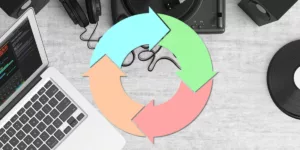In order for a B2B venture to achieve success and the fabled “Tornado” stage of 45% unit growth rates, a company must move beyond early adopters and dominate mainstream markets. Whether the venture offers a new wearable, an AI product, or a cloud-based CRM solution, real revenue growth comes with customer success at scale. The mission – a company must transition its product or solution, in a systematic manner, through the Technology Adoption Life Cycle (TALC) by understanding the different customer needs in each stage.

Breaking Down the Stages
The first group of customers in the Technology Adoption Life Cycle are the “Techies”. They’re the early adopters who are interested in the newest and most innovative apps / platforms / services.
Next are the “Visionaries”. Think Steve Jobs’ and similar members of the tech community (or as close as others can get to his iconic status). Members of this group have more capital on hand and have the insight to envision breakthrough uses for new technologies.
After the Visionaries are the “Pragmatists” – the most crucial group of B2B customers, as their acceptance of a new product category sets the stage for broader acceptance and mainstream adoption. This is 35% of your customer base, which is reached after successfully crossing the “chasm.” When this group begins to buy en masse, then the “Tornado” phase occurs with explosive growth. Think iPods, iPads, and iPhones. But Appple Watches – no, not yet.
Next are the “Conservatives” who need additional inducements in order to buy the new category. The “whole product” needs to be safe, stable, proven and robust – or else they will not buy. They’re the late adopters, but still important as they represent another 35% of the addressable market.
And finally we have the “Skeptics” — these are not a target customer and often serve as impediments to full adoption by the market. They’re not excited about the solution or its ability to provide innovation, and question the need for such a technology. If you’ve met someone who still uses a rotary dial phone, then you know what I’m talking about here !
Diving Deeper into the Waters
The Techies are individuals who are willing to experiment actively with Beta versions, and to support your efforts, and are best of all — willing to accept an 80% whole product. Unfortunately, there aren’t enough of these people.
The Visionaries are not always tech savvy – but they are always the ones willing to take a risk in order to gain competitive advantage. Not necessarily because they love your product unequivocally, but because they see its potential to provide them with a sustainable competitive advantage over the next one to two years.
After this stage, we reach the “Chasm,” which we have discussed at length in other articles and presentations. The chasm must be crossed in order for a company to reach mainstream success and to achieve sustained and long-term profitability. To cross this chasm, you need to provide a 100% “whole product” to the Pragmatist customer base – i.e. a complete solution, which includes pre-sales, training, documentation, support, and a migration path. Without these enablers, you will not get to the mainstream market.

Crossing the chasm means winning the hearts and minds (and loyalty) of Pragmatists. Companies need to market their products differently to this group, than they did in the Early Market. Consider a company in the biofuels segment that has a Nobel Prize-winning technology that turns organics into usable fuel. The Techie and Visionary customers will really pay attention to the Nobel Prize and be impressed by this incredible scientific achievement. For Pragmatists, however, that same Nobel Prize might represent a risk – that it is an unproven and experimental technology and not ready for “prime time”.
Marketing to the pragmatists is clearly a challenge and requires a different way of thinking, since they expect a more proven brand, an established track record, and key industry partnerships as “ insurance” before buying. Provide them with a sense of stability and robustness, rather than trying to excite them with breakthrough technologies.

A crucial step for any startup is to accurately and realistically assess what stage they are currently competing in, and then develop product features and go-to-market strategies that appeal to this appropriate stage. This is easier said than done. Are the “techies” the only group currently interested in what you have to offer? Change tactics to attract the visionaries who can provide you with valuable implementation opportunities and funding. Is your product category further along and ready to “cross the chasm?” Then you must focus in on the needs of the pragmatist market.
When you are trying to cross the chasm – it is definitely time to stop asking visionaries what else you they need – and instead ask the pragmatists why they have not yet adopted the new product category, to figure out what’s missing from your current whole product.
Bottom-line: always consider the needs of your current stage of adoption, as well as one eye on the customer group to the right of where you are currently competing on the Technology Adoption Life Cycle. By doing this, you’ll be dramatically raising the probability for long-term success and profitability.
————————
Your thoughts, comments, and questions are always welcome.
Feel free to contact me at the LinkedIn link below:
Michael Eckhardt
Managing Director and Senior Workshop Leader at Chasm Institute’s Silicon Valley Office








